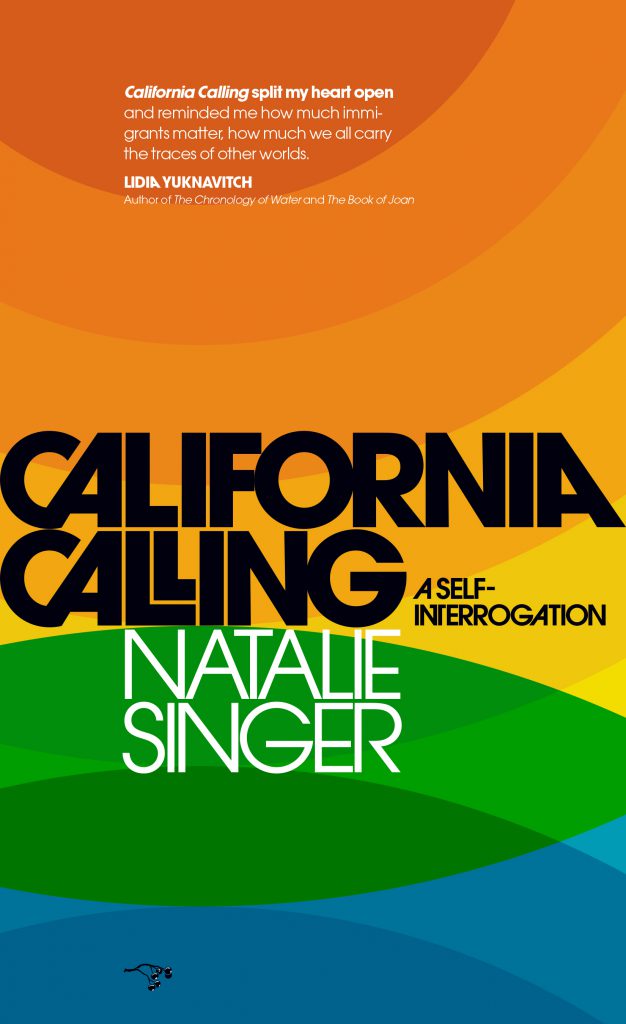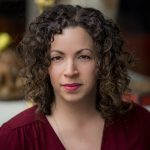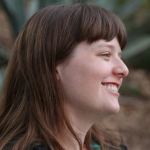When I first skimmed a galley of Natalie Singer’s California Calling, I felt–there’s no other word for it—spooked. I glimpsed words and phrases about California as a mythic place, about aching for it before you really know what it is, about how being there and being gone from there and longing for there are all one state of mind. These are thoughts I’ve had, too, as I negotiate and deepen my own love affair with California. It was like dreaming of a word and then having that word appear everywhere the following day. Had I written this book? No, of course not, it’s Singer’s book and Singer’s love affair. But I felt a kinship forming.
 Reading the book overwhelmed me. Its subtitle, “A Self-Interrogation,” is the first indication that it’s constructed as a series of answers to questions, and is sectioned out through the well-established stages of interrogation (as well as some stages of Singer’s own invention). But within these strategies and structures, California Calling presents itself without artifice, without hand-holding. It is unquestionably, unforgettably Singer’s story, as well as an expert chronicle of California’s ineffabilities.
Reading the book overwhelmed me. Its subtitle, “A Self-Interrogation,” is the first indication that it’s constructed as a series of answers to questions, and is sectioned out through the well-established stages of interrogation (as well as some stages of Singer’s own invention). But within these strategies and structures, California Calling presents itself without artifice, without hand-holding. It is unquestionably, unforgettably Singer’s story, as well as an expert chronicle of California’s ineffabilities.
The opportunity to connect with her, to pick her brain about the story behind the stories she tells so fearlessly in this memoir, was an honor.
Katharine Coldiron: So, first off, I see the irony of interviewing you about a book that’s structured as an interrogation.
Natalie Singer: I’ve been thinking about this as I’ve been doing interviews for the book. In one way, it fits nicely to be questioned—I’m in that mode already, and as a rule-follower whose gut instinct is to please (even as I recognize how problematic that instinct has been for me and many girls and women), I do well answering questions. On the other hand, it makes it harder to distinguish between the book itself and the life of the book. And author interviews, while I love them-and feel especially lucky to be talking with you, whose work I so admire-also induce anxiety similar to that sometimes brought on by the interrogative voice in my book: is it friendly, is it suspicious of my viewpoint? Will it believe me? But again, that unease mirrors the book well.
KC: I don’t think I need to know who the interrogator of California Calling is in a concrete way, but I want to know if s/he/it had a specific identity to you as you were writing.
NS: It’s less of a single identity than something that functions as the nucleus of a collection of interrogative energies or identities that I’ve tussled with or been subjected to. Maybe a multiple-personality identity. That said, I want to leave it open for the reader to interpret the identity as she is compelled to.
KC: That’s an instinct I admire. Leaving my work open to interpretation, and embracing those varying interpretations, has risen to paramount importance for me in the past couple of years, but it’s a challenge.
NS: Thank you. It’s actually a source of tension for me, too. Because I can be an Alpha-no, I need to be more honest; I am an Alpha—so I also like to be in control of things. In an argument or a debate, or any conversation about a complex topic, really, I like to state my case, and get my say so that it’s absolutely clear to me that the other person understands exactly where I am coming from. When we first got together my husband noted that in a fight I “obliterate.” Not in any kind of abusive way or anything, but in a lawyerly way. I tend to like to be thorough. So this instinct, to allow space in my writing for the reader to adopt their own meaning, is both something I feel is important but also can be challenging for me. I have to consciously resist putting everything inside of me on the table. I know my writing can be more nuanced and relevant to readers if I do.
KC: Where did the specific questions come from? Some of them seem like catechism, but some of them seem like writing prompts. I’m a student of Lidia Yuknavitch, who blurbed you, and I thought I might’ve recognized some of your questions from her instruction.
NS: I am endlessly inspired by Lidia’s writing, though I’ve never had the luck of taking a class with her or being exposed to her exercises—I hope to one day! Practically, I was inspired in part by Bhanu Kapil’s use of questions in her brilliant work The Vertical Interrogation of Strangers. In terms of where the questions come from, and whether they were structured to surface intentional responses–that’s complicated. Much of the book, including many of the questions, were written corporeally, which I know is a space Lidia invites her students into. The questions I ask in the book came up from my cells, sometimes forcefully. It felt like I had been carrying them for generations. Writing them, and the answers, was instinctual but not proscriptive. Did the questions come as they did because I knew on some level the answers were necessary? I knew there were some stories I wanted to tell. But I never knew consciously what an answer would be, exactly, until I began to write it. So much of the process of writing this book the way I did felt intuitive.
KC: That’s beautiful, but I must shove it into the realm of the practical: how did you write this? Did you write in fragments and order them later? Write longer versions and trim them down to tiny bites? Did you write in order and mix it up later?
NS: All of the above. This book started years ago as a more traditional narrative memoir. And while narrative sections still exist and help to drive the story forward, overall the book is what I would classify as a hybrid—a lyric memoir, a fragmented memoir, a found-form work. So how did I get there? As I went deeper into the work, I began to see that beyond the surface coming-of-age story there were broader themes related to the silencing of girlhood, the legacy of interrogation, the impermanence of the California myth and of all of our personal mythologies. To get at these themes, to interrogate them, I felt I had to reduce and distill.
One writer I was influenced by was Maggie Nelson, specifically her book Bluets. I could see the power of the fragment, and of investigating grief by sometimes looking around and to the side of it, rather than directly at it. I sensed that fragments could help me construct a whole. I was also influenced by Lydia Davis, who tells us that form is a response to doubt. To work deliberately in the form of the fragment, she says, “can be seen as stopping or appearing to stop a work closer, in the process, to what Blanchot would call the origin of writing, the centre rather than the sphere.” If we capture only a little of our subject, Davis says, we have “allowed it to live on at the same time, allowed it to live on in our ellipses, our silences.” Silence is an important theme in my book, and I began to shape the book around the question of whether form can be a response to silence.
KC: Interesting. I appreciate, but don’t enjoy, Davis because I find her so clinical. Like a taxidermist. Your book is deeply felt and corporeal. Would you say you’re using her technique but not her style?
NS: I agree with that. For me, some of her ideas functioned as a jumping-off point, an invitation to start thinking more deeply about my own poetics and about the use I could make of fragmentation or omission. I could not strip down as much as Davis.
KC: Since the book is in fragments, in sideways gestures rather than straight narrative, do you feel as if you’ve told the whole story?
NS: I feel actually like I’ve told more of the story than I could have with a traditional, complete narrative. It’s hard to crystalize, but one reviewer from Foreword Reviews touched on it when they wrote that as powerful as what I do share in the book are the things I choose to mute or conceal. I was so grateful when I read that, because that was my goal. To palpate the hardest-to-touch things by grazing the edges of grief, or hurt, or ecstasy and to interrogate silence itself to see how it functions.
KC: How do you answer questions about where you’re from? A childhood spent moving around, locating various definitions of home, leads to awkward answers to this common question.
NS: One way I attempted to answer this question is by writing the book. I don’t mean to be facetious! I have always had a hard time with this question, because I was transplanted to California at the age of sixteen, right when I was ready to imprint on a place but also already forged by the place I came from. I wanted to explore with the book the moment of assimilation-be it into a place, a person, or ourselves. How does allegiance form? Even now I have a hard time saying where I am from in a soundbite, which I think is an increasingly common experience as so many of us shift across geographies and cultures, melding and re-classifying ourselves. This is the alchemy of identity today.
KC: One of the threads I found visible in the book again and again is loneliness. Was that something you set out to write about, or merely a theme that kept appearing during this period of your life?
NS: t’s a theme that emerged, although the girl me would have known-maybe without being able to verbalize it-that loneliness is at the center of everything. Now I recognize it as a driving theme of my life, so much so that my next book is kind of an investigation or shakedown of loneliness.
KC: Why did you leave California? This book is written about a time in your life that’s long past; what is California to you today?
NS: Sometimes I think I left because at the time, I couldn’t conceive of how much my identity had become entangled with that place. Factually, I left for a job and then life, with all its attachments, evolved out of that. But I didn’t know that, after leaving, I would miss the panorama of a California freeway or the smell of the ocean ruffling a palm frond like a phantom limb. Ironically, because I left it, California has in a way reverted to a mirage or a myth for me, a place I yearn for but that, once again, I don’t have.
KC: Los Angeles does not figure into the book at all. Since so many people think only of Hollywood when they think of California, was leaving it out a purposeful choice?
NS: Primarily no, not intentional at all. I lived in a handful of different places in California, but never in L.A. The closest place to L.A. that I lived was the Colorado Desert, and I decided early on not to set the story in any region I hadn’t spent enough time in to really feel I had come to know it. So part of me wishes that I had experienced more of that mythical L.A. in order to include it in this book, but I also think there is something interesting in its omission.
An undercurrent in the book is this examination of the California myth and more broadly the commanding myths we are all raised up on and chase after. The promise, or mirage, of Hollywood glamour has in part come to define the California myth-in fact it’s the only thing many people around the country and world know about the land we now call the state of California. But historically the draw of the place, and the roots of our desire around what California has come to symbolize to us, whether we’ve lived there or never been, are anchored not in Hollywood but in other regions, cities and towns. So maybe L.A.’s absence can allow us to see this lore, and lure, in new ways.
KC: I’m so impressed by your intention to tackle California as a myth, both culturally and personally. That’s a big ambition.
NS: Well, it almost feels like a transgression. Like how dare we, how dare I, question the promise, the prospect, of the California myth or the American Dream? But I’m oriented toward transgression. You have to be an outsider of some kind, I think, to want to—or feel compelled to—deconstruct a mythical institution. I did feel like an outsider, and the worst kind-the kind who is dying to be in the club, to belong. So I think I felt that if I could unpack some of these myths, maybe I could make a space for myself to slip inside, to integrate.
KC: It seems as if your evolution as a writer has included a shift from dedicated journalism to dedicated creative work. Is this accurate? How does the shift feel to you?
NS: Yes. For about 15 years I worked as a newspaper journalist and never-never-wrote the word “I.” As a journalist you are taught that objectivity is at the core of everything, and by keeping yourself out of the story you are able to more fairly tell the stories of others. After I had my second child, I came to a rough place. At work I covered murder and rape cases, the worst things you can think of. I had been working earnestly on making space for others’ voices for so long, and I had gone through some very powerful changes in my own life-becoming a mother and now caring for two daughters under age three; seeing my own parents age and get sick. Questions I had about my own girlhood started to press in on me and I felt the urge to explore my own stories. I took a career break and began to write creatively. It was very hard at first to write about myself: I felt guilty, like I had broken an oath and was doing something only very bad girls do. But I soon found that my journalism background was very useful to my creative work. As a journalist you learn to listen deeply to others and to follow intuition; this helps me be gentle and perceptive with myself. These days I do occasional journalism and I write creatively.
KC: I noticed that wordplay has a large part in your work. The multiple meanings of “state,” for instance. Every word seems to matter, to have subtext. Can you speak to that?
NS: It can be freeing or constraining, right? My work has definitely curved more toward the lyric and poetic in recent years, finding a deeper permission in the language itself than it did early on. But I think the roots of this go back to my journalism training, which teaches you to make every single word count, to pare down and “kill your babies,” to not be lazy with language and to recognize the power of it. I often find that when I cannot find the answer to something in my memory, or when my logical, critical, or intellectual thinking falls short, I can turn to language and mine it. For instance, playing with the homonym “state” enabled me to investigate connections between place and voice, between geography and utterance. Language illuminates.
You can read an excerpt of CALIFORNIA CALLING in our latest quarterly issue, themed REUSE.
 NATALIE SINGER is the author of California Calling: A Self-Interrogation (Hawthorne Books, March 2018). Her writing has been published in Literary Mama, The Washington Post, The Seattle Times, ParentMap, Alligator Juniper, Brain, Child and Full Grown People, among others. She has taught writing inside Washington State’s psychiatric facility for youth and Seattle’s juvenile detention center, and she has worked as a reporter at newspapers around the West. Natalie earned her MFA in Creative Writing and Poetics from the University of Washington. Originally from Montreal, she lives in Seattle. (@Natalie_Writes)
NATALIE SINGER is the author of California Calling: A Self-Interrogation (Hawthorne Books, March 2018). Her writing has been published in Literary Mama, The Washington Post, The Seattle Times, ParentMap, Alligator Juniper, Brain, Child and Full Grown People, among others. She has taught writing inside Washington State’s psychiatric facility for youth and Seattle’s juvenile detention center, and she has worked as a reporter at newspapers around the West. Natalie earned her MFA in Creative Writing and Poetics from the University of Washington. Originally from Montreal, she lives in Seattle. (@Natalie_Writes)
 KATHARINE COLDIRON‘s work has appeared in Ms., the Rumpus, Anomaly, the Offing, and elsewhere. She lives in California and blogs at the Fictator.
KATHARINE COLDIRON‘s work has appeared in Ms., the Rumpus, Anomaly, the Offing, and elsewhere. She lives in California and blogs at the Fictator.
Leave a Reply